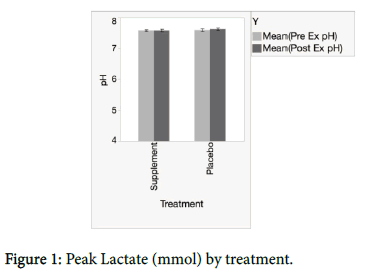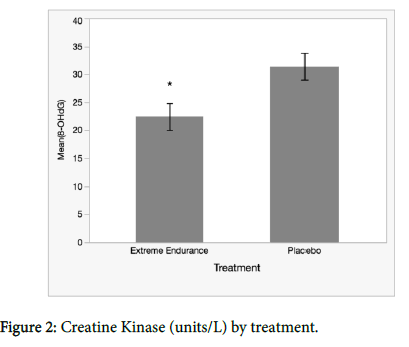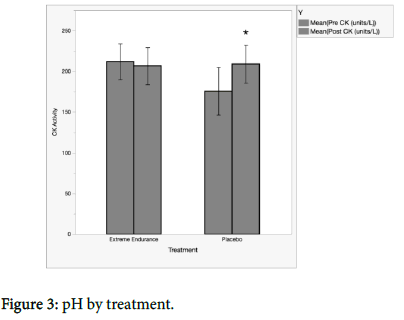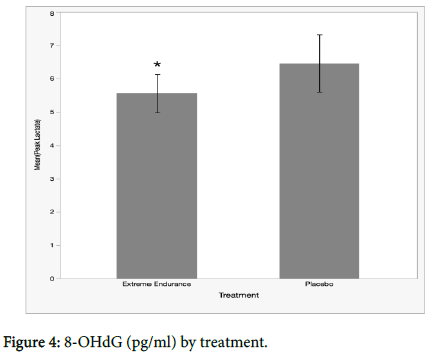Research Article, J Athl Enhanc Vol: 7 Issue: 2
The Effects of 10 Days of a Multi- Ingredient Supplement on Performance Lactate during Exercise and Post Exercise Muscle Damage, Oxidative Stress and Inflammation
Soileau J1, Judge LW2 and Bellar D3*
1Pennington Biomedical Research Center, Baton Rouge, LA, USA
2School of Kinesiology, Ball State University, Muncie, IN, USA
3School of Kinesiology, University of Louisiana at Lafayette. Lafayette LA, USA
*Corresponding Author : David Bellar, Ph.D.
Director – School of Kinesiology University of Louisiana at Lafayette 225 Cajundome Blvd Lafayette, LA 70506, USA
Tel: (337) 482-6615
Fax: (337) 482-6278
E-mail: dbellar@louisiana.edu
Received: April 11, 2018 Accepted: May 11, 2018 Published: May 18, 2018
Citation: Soileau J, Judge LW, Bellar D (2018) The Effects of 10 Days of a Multi-Ingredient Supplement on Performance Lactate during Exercise and Post Exercise Muscle Damage, Oxidative Stress and Inflammation. J Athl Enhanc 7:2. doi: 10.4172/2324-9080.1000289
Abstract
Intense and prolonged bouts of intense exercise can cause metabolic acidosis due to the accumulation of intramuscular hydrogen ions. The purpose of the investigation was to assess the efficacy of a calcium bicarbonate sport supplement to enhance exercise performance and recovery. Sixteen healthy, active, college-aged males were recruited to participate in the investigation. Participants in this cross-over study had two tenday
supplementation periods separated by a ten-day washout period. Performance measures were tested and recorded via graded exercise tests on a cycle ergometer at baseline, as well as after both supplementation periods. Blood samples were acquired at baseline as well as pre- and post-exercise after both trial periods to assess levels of ammonia, 8-OHdG, creatine kinase, lactate dehydrogenase, and C-reactive proteins, IL-2, IL-6, and TNF-Alpha markers. ANOVA revealed significantly lower levels (treatment vs. placebo) by time (baseline, day ten) for 8-OHdG post exercise (main effect F=6.98, p=0.013). Creatine kinase levels demonstrated a significant interaction effect (main effect F=0.267, p=0.608; treatment * time: F=3.05, p=0.04). Additionally, a significant difference in peak lactate was noted by treatment (t=1.67, p=0.05, 3.8 mmol supplement vs. 4.8 mmol placebo). Significant differences were not found for aerobic performance measures, ammonia, C-reactive proteins, Interleukin-2, Interleukin-6, or TNF-alpha. The results of the present investigation provided initial evidence for the use of the multiingredient supplements. This preliminary evidence suggests the supplement may blunt lactate response to exercise and help provide some protection from muscle damage and oxidative stress.
Keywords: Ammonia; Creatine kinase; Oxidative stress
Introduction
Increasing the performance or tolerance for high intensity exercise has been a subject of intense study and of great interest to the sports and fitness community. It is well known that high intensity exercise presents and acid-base challenge to the body. Additionally, it has been reported that pre-exercise acidosis effects anaerobic metabolism and power output during a 4 k time trial [1].
It has also been shown that training can influence the ability of the body to handle the acid-base challenges presented during high intensity effort by increasing acid-base handling proteins [2]. While these results are a promising step forward in terms of understanding, the influences of intensity and the aforementioned adaptations are not fully elucidated. Therefore, other means of increasing high intensity exercise performance have been the focus of much study.
There have been many attempts throughout the history of sport nutrition to develop a supplement that can offer buffering during exercise [3]. A recent review highlighted that a 300 mg/kg dose of sodium bicarbonate can potentially offer ergogenic benefits to single bouts of supramaximal or high intensity exercise [4]. This same review also suggested that time of acute doses was important and should be based upon the individual’s unique time to peak pH or blood bicarbonate concentration. It should be noted that the results regarding sodium bicarbonate are not conclusive, and vary greatly by exercise type and intensity. A recent study examined maximal force and rate of force development with a dose of 300 mg/kg of sodium bicarbonate versus placebo and reported no change in performance after 2 min of tetanic simulation [5].
Another compound that can buffer acidosis is carnosine. The levels of carnosine in skeletal muscle can be increased via β alanine supplementation. C2C12 myocytes cultured in the presence of β alanine had improved oxidative metabolism and increased expression of GLUT-4 transporters [6]. A recent meta-analysis suggested an overall effect of β alanine on exercise performance, but noted that exercise type was a significant modifier of this effect [7]. Similarly it has been reported that 4 km time trial performance was affected by a dose of 6.4 g/day of β alanine but that 1 km and 10 km time trial performance was not effected [8]. Another recent study of 24 weeks of β alanine supplementation was effective at increasing muscle carnosine content and also improving high intensity cycling capacity [7].
While some studies have demonstrated promising results, there are also those that show that supplementation with carnosine and sodium bicarbonate together can elevate buffering capacity without a concomitant change in repeat sprint ability [9]. Given the issues surrounding time of supplementation and possible gastrointestinal discomfort associated with sodium bicarbonate, alternative supplements with the potential to increase buffering capacity warrant investigation. One such supplement that containing a proprietary mixture was shown promising results related to buffering during an acute clinical trial on a group of male athletes [10]. In this study power exercise lactate was reduced as compared to placebo after a graded exercise protocol to exhaustion, suggesting an effect on exercise buffering. Additionally, this blend contains black pepper fruit which in turn has piperine as the primary bioactive compound. Piperine has been shown to reduce oxidative stress by acting as an anti-oxidant [11]. Further evidence of an anti-oxidant effect of black pepper was reported from a study of diabetic rats that when treated with P. nigrum (black pepper) had increased antioxidant potential [12]. This blend also contains papain (a protease) that has been shown to enhance muscle recovery and reduce inflammation post exercise [13,14]. Based upon the initial clinical evidence for reductions in post-exercise lactate and the composition of the blend the present investigation was designed to assess the effects of this supplement on performance, oxidative stress, inflammation and muscle damage.
Methods
Experimental design
The experiment was a repeated measures, placebo controlled, double blind design. The experimental procedures were reviewed by the Institutional Review Board at the University of Louisiana at Lafayette. All participants gave written informed consent prior to beginning experimental procedures.
Participants
Participants were 16 healthy recreationally active males (Age: 27 ± 2.6 yrs, Height: 181.1 ± 9.4 cm, Weight: 92.0 ± 18.2 kg, Body fat %: 15.4 ± 8.2). The present study was reviewed and approved by the Institutional Review Board at the University of Louisiana at Lafayette. All participants gave written informed consent prior to being enrolled in the study.
The participants reported to the human performance during the morning hours after an overnight fast and had their height and weight determined via a triple beam balance with stadiometer, and their body fat % determine via a Bod Pod Gold Standard system. Baseline data collection concluded with a 25 watt ramp protocol with expired gases monitored by a COSMED Quark CPET to determine VO2 max. Following the baseline assessment participants were given information about the supplementation scheme and when to report to report back to the lab. Additionally, participants were informed about the 48 h exclusion period for exercise and non-steroidal anti-inflammatory drugs prior to their next lab visit.
Supplementation phase
After these baseline assessments the participants were assigned to a random order of supplementation with either placebo or supplement (Extreme Endurance, Lifespan International LLC) for ten days. Supplement consisted of a proprietary blend of calcium carbonate, papain, magnesium oxide, potassium, magnesium hydroxide, catechins, selenium, chromium, and black pepper fruit. Randomization was generated through coin flip to determine first allocation. The first 4 days will the participants ingested four tablets in the morning and evening (8 tablets total) followed by 6 days of three tablets in the morning and evening (6 tablets total).
Exercise trials
Following the supplementation period, the subjects reported to the human performance lab where they had a baseline blood draw and were fitted with a mask to collect expired gases and will perform a 25- watt ramp protocol on an electronically braked cycle ergometer. During this test the subject had a short warm up period, and then a computer automatically adjusted the workload on the bike such that a slope of 25 watts/min was achieved. The test concluded when the subject reaches volitional exhaustion. Expired gases were assessed with a COSMED QUARK CPET system. Prior to, and every two minutes during the exercise lactate was assessed via dermal puncture and a handheld monitor (Nova Biomedical Lactate Plus, Nova Biomedical Corporation, Waltham MA USA). Following the cessation of exercise, a post exercise blood sample was collected. The participants then rested for 10 min prior to completed an additional 1min of exercise a 150% of the power at VO2 max and had and additional blood draw. The blood samples were spun down in a clinical centrifuge and the serum drawn off and ammonia determined via enzymatic reaction. The remaining serum was stored at -80 degrees Celsius for later analysis (muscle damage, oxidative stress, inflammation). Participants then have a ten-day rest period after which they will begin the 10 day supplementation period and exercise trial with the opposite supplement.
Blood analysis
Plasma ammonia levels were determined using a colorimetric assay (Ammonia Assay, St. Louis MO USA). Muscle damage was assessed in serum using commercially available Creatine Kinase (CK, Creatine Kinase Activity Assay Kit, Sigma-Aldrich Co. LLC, St. Louis MO USA) and Lactate Dehydrogenase (LDH, Lactate Dehydrogenase Activity Assay Kit, Sigma- Aldrich Co. LLC, St. Louis MO USA) activity assays. Oxidative Stress was assessed using a commercially available 8OHdG assay kit (OxiSelect Oxidative DNA damage ELISA kit, Cell BioLabs Inc, San Diego CA USA). Finally, inflammation was analyzed using a custom chemilumenscent multiplex assay (Custom Q-plex assay, Quansys Biosciences, Logan UT USA).
Statistical analysis
Data were analyzed via repeated measures Anova to determine main and interaction effects (treatment*time). All analyses were conducted using JMP 13.0 Pro statistical software. Statistical significance was established a priori at p<0.05
Results
Performance measures
The peak wattage achieved during the graded exercise test did not statistically differ between trial (F=0.016, p=0.901). The supplement treatment resulted in a mean performance of 244.7 watts and the placebo 247.5 watts.
Peak lactate
When examining peak lactate change from baseline during the graded exercise test, the supplement treatment was associated with statistically lower lactate accumulation (p=0.05). The change in lactate concentration (mmol) when supplementing with Extreme Endurance was 3.8 whereas the placebo treatment resulted in a change of 4.8 (26% greater). When examining the peak lactate concentration, the participants were at 5.5 mmol with supplement vs. 6.5 mmol with placebo without a difference in peak power achieved. See Figure 1.
Creatine kinase
Statistical analysis via repeated measures Anova demonstrated a significant interaction effect for treatment by time (F=3.05, p=0.04). The CK levels were 211 (units per liter) pre exercise with extreme endurance and declined to 206 (reduction of 2.5%) whereas in the placebo condition the pre exercise level as 175 and increased to 208 (an increase of 19%). Post-hoc testing revealed that the placebo group had a significant increase in CK pre –post exercise (t=2.09, p=0.026) whereas the supplement treatment did not (t=-0.34, 0.368). See Figure 2.
Lactate dehydrogenase
Statistical analysis via repeated measures Anova did not demonstrate any significant treatment or treatment by time effects for LDH levels. Analysis did reveal that exercise trials for both treatment conditions resulted in similar post exercise increases in LDH levels (F=16.13, p<0.001). Overall means for pre exercise were 63.3 milliunits/ml vs 85.3 milliunits/ml post exercise.
Plasma ammonia concentrations
Post 150% VO2 max exercise no statistical differences were noted between treatments (F=0.284, p=0.598). Post exercise Ammonia was 356.7μ g/ml for the supplement condition and 284.3μ g/ml for the placebo condition.
Plasma pH changes
Repeated Measures Anova did not reveal a significant difference between changes in pH pre to post exercise by treatment. (Main effect F=0.427, p=0.519, treatment*time interaction F=0.0793, p=0.780). See Figure 3.
Oxidative stress
Anova revealed a significant different between the treatments (F=6.89, p=0.01). Supplement values post exercise were 22.5 pg/ml vs. 31.4 pg/ml for placebo. See Figure 4.
Multiplex inflammation assay
The data for TNF-α , IL-2, IL-6 and C-reactive protein were not statistically different by treatment post exercise (TNF-α F=0.022, p=0.883; IL-2 F=1.57, p=0.219; IL-6 F=0.097, p=0.758; C-reative protein F=0.699, p-0.410).
Discussion
The results of the present study demonstrate strong evidence for the effectiveness of the tested supplement to modify exercise lactate response and recovery. The peak lactate concentration was blunted while on the supplement in a similar fashion to the original study involving this product suggesting a possible increase in reliance on aerobic metabolism or increase in aerobic efficiency [10]. This reduction is important given that increased lactate levels during exercise have been shown to be associated with degraded running economy in high level athletes [15]. Furthermore, metabolic acidosis has been shown to be related to worsening performance and fatigue onset during a repeated sprint test [16,17]. It is possible that some benefits for athletic performance could be gained from the changes associated with lactate and the tested supplement, however, it should be noted that no changes in actual performance were revealed by the present study in a graded exercise test. This may be due to the exercise mode, further study of this supplement with repeated sprint tests and time trial type exercise tests is warranted to determine the effects on exercise performance.
In addition to the effect on exercise lactate concentration the study demonstrated a reduction in CK levels suggesting a reduction in muscle damage. It should be noted that no change was reported for LDH in the present study in a similar fashion to a recent study of Sesame supplementation [17]. Another study that examined CK and LDH post exercise with Pomegranate supplementation reported a larger magnitude reduction in CK as compared to LDH (11.3% vs. 7.3%) [18]. Based upon this it may be that CK is effected to a larger magnitude post exercise that thus differences are more easily resolved as compared to LDH. Nonetheless the relatively flat CK levels with the supplement pre to post exercise as compared to the 19% increase with placebo cannot be discounted as evidence of a change in muscle damage. Similarly, the evidence for reductions in post exercise oxidative stress via 8OhDG measures resulted in a large difference between placebo and supplement. Taken together there is strong preliminary evidence to suggest that the tested supplement can reduce muscle damage while supporting defense against oxidative stress.
The present study provided preliminary evidence for the tested supplement but has limitations. The study was conducted with only one form of exercise assessment thus the results may not translate to other exercise modes. Additionally, the convenience sample of recreationally active males may not have resulted in generalizable data for female or athletic populations. Further research is needed to clarify the effectiveness of the tested supplement for additional populations and exercise types.
The data examined so far supports the use of this proprietary blend as a sport nutrition supplement. The data demonstrates that similar, high intensity, exercise was associated with lower lactate levels suggesting increased efficiency. Additionally, the reduction of CK levels post exercise (especially when examined against the increase seen with placebo) suggests that this supplement may possibly help combat muscle damage associated with exercise. Finally, the reduction in oxidative stress post exercise suggests a role in in protection from free radical damage that is likely to enhance recovery from exercise.
Acknowledgements
The present study was partially funded by a research grant from Lifepan International LLC.
References
- Correia-Oliveira CR, Lopes-Silva JP, Bertuzzi R, McConnell GK, Bishop DJ, et al. (2017) Acidosis, but not alkalosis, affects anaerobic metabolism and performance in a 4-km time trial. Med Sci Sports Exerc 49: 1899-1910.
- McGinley C, Bishop DJ (2016) Influence of training intensity on adaptations in acid/base transport proteins, muscle buffering capacity, and repeated-sprint ability in active men. J Appl Physiol 121: 1290-1305.
- Lancha Junior AH, Painelli Vde S, Saunders B, Artioli GG (2015) Nutritional strategies to modulate intracellular and extracellular buffering capacity during high intensity exercise. Sports Medicine 45 Suppl 1: 71-81.
- McNaughton LR, Gough L, Deb S, Bentley D, Sparks SA (2016) Recent developments in the use of sodium bicarbonate as an ergogenic aid. Curr Sports Med Rep 15: 233-244.
- Siegler JC, Mudie K, Marshall P (2016) The influence of sodium bicarbonate on maximal force and rates of force development in the triceps surae and brachii during fatiguing exercise. Exp Physiol 101: 1383-1391.
- Schnuck JK, Sunderland KL, Kuennen MR, Vaughan RA (2016) Characterization of the metabolic effects of b alanine on markers of oxidative metabolism and mitochondrial biogenesis in skeletal muscle. J Exerc Nutrition Biochem 20: 34-41.
- Saunders B, Elliot-Sale K, Artioli GG, Swinton PA, Dolan E, et al. (2017) b alanine supplementation to improve exercise capacity and performance: a systematic review and meta-analysis. Bri J Sport Med 51: 658-669.
- Bellinger PM, Minahan CL (2016) The effect of b alanine supplementation on cycling time trials of different length. Eur J Sport Sci 16: 829-836.
- Danaher J, Gerber T, Wellard RM, Stathis CG (2014) The effect of β-alanine and NaHCO3 co-ingestion on buffering capacity and exercise performance with high-intensity exercise in health males. Eur J Appl Physiol 114: 1715-1724.
- Kellermayr G, Kellin S, Greilberger J (2010) Supplementation with athletic performance formula decreases lactate concentrations in trained athletes after exhausting incremental cycle ergometer test. Clinic Nutri Suppl 5: 9.
- Srinivasan K (2007) Black pepper and its pungent principle-piperline: a review of diverse physiological effects. Crit Rev Food Sci Nutr 47: 735-748.
- Kaleem M, Sheema, Sarmad H, Bano B (2005) Protective effects of Piper nigrum and Vinca rosea in alloxan induced diabetic rats. Indian J Physiol Pharmacol 49: 65-71.
- Buford TW, Cooke MB, Redd LL, Hudson GM, Shelmadine BD, et al. (2009) Protease supplementation improves muscle function after eccentric exercise. Med Sci Sports Exerc 41: 1908-1914.
- Miller PC, Bailey SP, Barnes ME, Derr SJ, Hall EE (2004) The effects of protease supplementation on skeletal muscle function and DOMS following downhill running. J Sports Sci 22: 365-372.
- Hoff J, Støren Ø, Finstad A, Wang E, Helgerud J (2016) Increased blood lactate level deteriorates running economy in world class endurance athletes. J Strength Cond Res 30: 1373-1378.
- Padulo J, Tabben M, Ardigo LP, Ionel M, Popa C, et al. (2015) Repeated sprint ability related to recovery time in young soccer players. Res Sport Med 23: 412-423.
- Barbosa CV, Silva AS, de Oliveira CV, Massa NM, de Sousa YR, et al (2017) Effects of Sesame supplementation on creatine kinase, lactate dehydrogenase, oxidative stress markers, and aerobic capacity in semi-professional soccer players. Frontiers in Physiology 8: 196.
- Ammar A, Turki M, Chtourou H, Hammouda O, Trabelsi K (2016) Pomegranate supplementation accelerates recovery of muscle damage and soreness and inflammatory markers after a weightlifting training session. PLoS ONE 11: e0160305.
 Spanish
Spanish  Chinese
Chinese  Russian
Russian  German
German  French
French  Japanese
Japanese  Portuguese
Portuguese  Hindi
Hindi 




